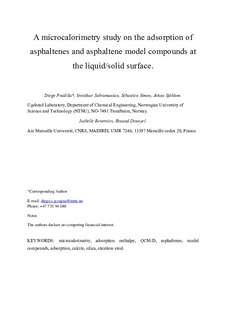Microcalorimetry Study of the Adsorption of Asphaltenes and Asphaltene Model Compounds at the Liquid–Solid Surface
Pradilla Ragua, Diego Camilo; Subramanian, Sreedhar; Simon, Sebastien Charles; Sjøblom, Johan; Beurroies, Isabelle; Denoyel, Renaud
Journal article, Peer reviewed
Accepted version
Permanent lenke
http://hdl.handle.net/11250/2478979Utgivelsesdato
2016Metadata
Vis full innførselSamlinger
Sammendrag
The adsorption of an acidic polyaromatic asphaltene model compound (C5PeC11) and indigenous C6-asphaltenes onto the liquid–solid surface is studied. Model compound C5PeC11 exhibits a similar type of adsorption with a plateau adsorbed amount as C6-asphaltenes onto three surfaces (silica, calcite, and stainless steel). Model compound BisAC11, with aliphatic end groups and no acidic functionality, does not adsorb at the liquid–silica surface, indicating the importance of polar interactions on adsorption. The values of the adsorption enthalpy characterized by the ΔHz parameter (the enthalpy at zero coverage) indicate that the type of adsorption and the driving force depend on the surface, a key feature when discussing asphaltene deposition. The adsorption of C5PeC11 onto silica is shown to be driven primarily by H bonding (ΔHz = −34.9 kJ/mol), unlike adsorption onto calcite where polar van der Waals and acidic/basic interactions are thought to be predominant (ΔHz = −23.5 kJ/mol). Interactions between C5PeC11 and stainless steel are found to be weak (ΔHz = −7.7 kJ/mol). Comparing C6-asphaltenes and their esterified counterpart shows that adsorption at the liquid–solid surface is not influenced by the formation of H bonds. This was evidenced by the similar adsorbed amounts obtained. Finally, C5PeC11 captures, to a certain extent, the adsorption interactions of asphaltenes present at the calcite–oil and stainless steel–oil surfaces.
